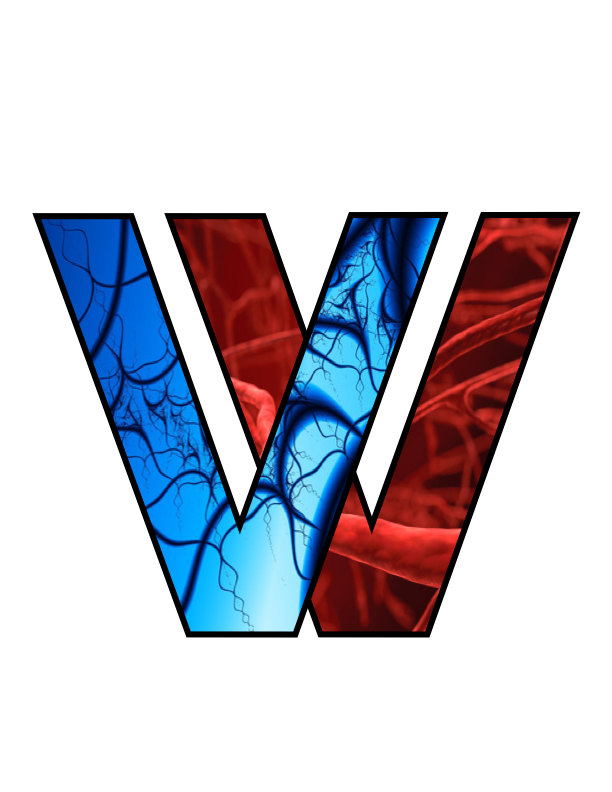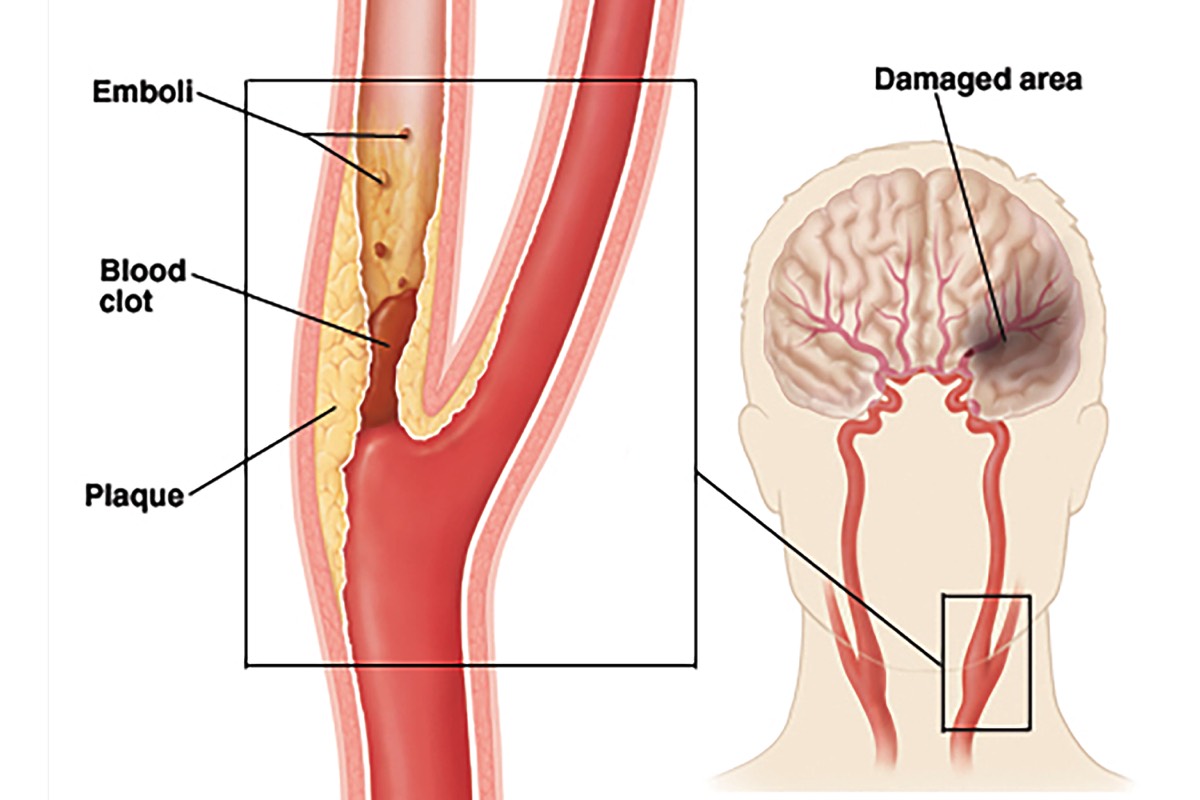-
Carotid Artery Disease
Carotid artery disease occurs when the major arteries in your neck become narrowed or blocked. These arteries, called the carotid arteries, supply your brain and eyes, with blood.
Normal Carotid ArteryNormal healthy arteries are flexible and have smooth inner walls, but as you age, a sticky substance called plaque, can collect inside these arteries. Plaque is made up of cholesterol, calcium, and fibrous tissue. As more plaque builds up, your arteries narrow and stiffen. This process is called atherosclerosis, or hardening of the arteries. When enough plaque builds up to reduce or disturb blood flow through your carotid arteries, physicians call this problem carotid artery disease. Carotid artery disease is a serious health problem because it can cause blindness or stroke.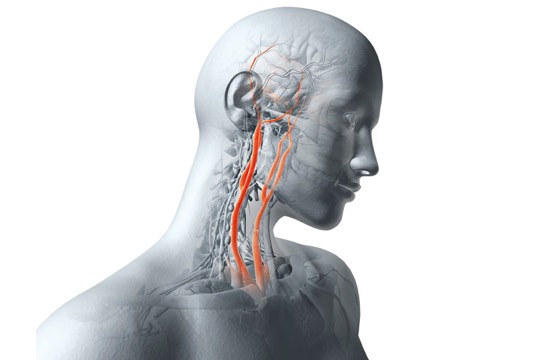
What is Transient Ischemic Attack (TIA)/StrokeA stroke or cerebrovascular accident (CVA), occurs when blood flow is compromised, resulting in brain tissue damage and loss of brain function. TIA’s are stroke like symptoms that are completely resolved within 24 hours.
CVA and or TIA occur when the carotid artery is severely narrowed (stenosis), due to a build-up of plaque within the artery, causing reduced blood flow to the brain and or fragments of the plaque or tiny blood clots (emboli) travel and block smaller arteries in the brain.
How A Stroke Can OccurThe surface of plaque may be rough. Blood can collect there and form clots. Also, plaque can rupture, causing pieces to break off and enter the blood stream. At the same time, rupture can produce more clots. Fragments of plaque and tiny blood clots (emboli) then travel to and block smaller arteries in the brain. This cuts off blood flow to a portion of the brain, resulting in stroke.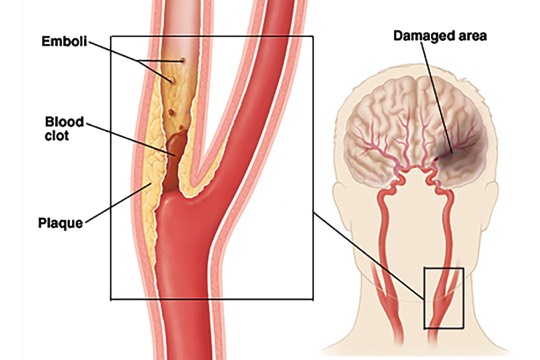 When blood flow is cut off, brain tissue can die, causing loss of brain function. This results in problems such as difficulty speaking or controlling movements. The exact symptoms depend on which part of the brain is affected. Symptoms often occur on one side of the body only, the side opposite the blockage. A stroke does permanent damage that can cause long-lasting loss of function.
When blood flow is cut off, brain tissue can die, causing loss of brain function. This results in problems such as difficulty speaking or controlling movements. The exact symptoms depend on which part of the brain is affected. Symptoms often occur on one side of the body only, the side opposite the blockage. A stroke does permanent damage that can cause long-lasting loss of function. -
What are the Symptoms?
Carotid artery disease may not cause symptoms in its early stages. Unfortunately, the first sign of carotid artery disease could be a stroke. However, you may experience warning symptoms, (TIA’s). These may include:
- Numbness on one side of the body
- Weakness, paralysis or loss of coordination on one side of the body
- Drooping on one side of the face or mouth
- Blindness or loss of part of the vision in one eye that typically is described as an experience similar to a shade being drawn over the eye.
- Loss of speech or garbled speech
- Inability to write or understand writing
- Episodes of memory loss
- Loss of consciousness
-
What are the Risk Factors?
Risk factors contributing to the hardening of the arteries, and the build-up of plaque, include:
- Smoking
- Diabetes
- High blood pressure
- Coronary artery disease
- Family history
- High cholesterol
- Poor diet and lack of exercise
-
How is the Diagnosis Made?
Our doctors will make a diagnosis based on your health history, physical exam, and certain tests to help determine if you have carotid artery disease.
During your physical exam, your doctor will ask you questions about your general health, medical history, and ask you about any symptoms you’ve been having. Plaque can form in blood vessels throughout your body. For that reason, our doctors will feel for pulses and listen for sounds of turbulent blood flow in your carotid arteries. If your physician suspects you have carotid artery disease, a carotid duplex scan will be performed, and further testing may be required, such as, CTA, MRA, or an angiography.
What is a Carotid Duplex Scan?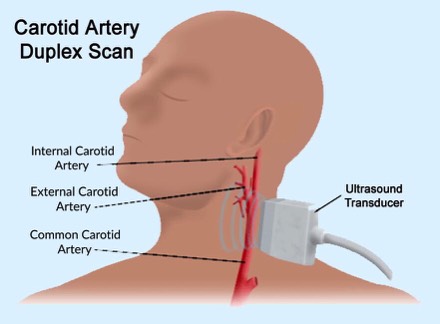
Ultrasonography is a painless, non-invasive test. A small transducer is pressed against the skin, utilizing sound waves to create images. A gel is applied to the skin to help the transducer create accurate images. The test checks for stenosis (narrowing) in the carotid arteries. It also shows how stenosis is affecting blood flow through the arteries. The results can indicate whether an artery is narrowed enough to require treatment.
What is a CTA?A CT (computed tomography) is a series of x-rays taken with a special machine. Computers use these x-rays to create three-dimensional images. CT angiography (CTA) requires injection of contrast fluid (dye) in a peripheral vein to make blood vessels visible on the x-ray image. CTA shows the arteries in the neck and head and will identify areas of arterial narrowing.
Inform your doctor if you are allergic to the contrast fluid (dye) given during CTA scan.
What is MRI/MRA?An MRI (magnetic resonance imaging) is a test that uses radio waves and magnetic fields to create detailed images of the body. To improve the tests accuracy, physicians sometimes inject a material called gadolinium, to make arteries more visible, this is referred to as an MRA (magnetic resonance angiography).
Inform your doctor if you are allergic to the contrast fluid (dye) given during MRA scan.
What is Angiography?This test is performed using a catheter inserted into an artery in the groin. A catheter is threaded into your arteries up to the neck and contrast dye is then injected through the catheter into the carotid artery, and x-ray images (angiograms) are taken.
Inform your doctor if you are allergic to the contrast fluid (dye) given during an angiography.
-
Treatment
Your treatment will depend on the severity of your condition, and whether or not you are having symptoms from the carotid artery disease, as well as your general health. The treatments available to treat carotid artery disease include; medical management, carotid angioplasty/stenting, carotid endarterectomy, and transcarotid arterial revascularization. Our doctors consider several factors when planning your treatment. These include the arteries affected, the site, the extent of the damage, and the presence and, or absence, of symptoms, as well as your overall health.
If you have other medical conditions, make sure to follow your physician’s instructions to manage them. For example, if you have diabetes, be sure to monitor and control your blood sugar levels. If you have high blood pressure, your physician may prescribe medications to lower it. If you are smoking, you should quit.
What is Carotid Angioplasty/Stent?Carotid angioplasty/stent, is a minimally invasive endovascular procedure performed under moderate sedation, for the treatment of carotid artery narrowing.
Stenting is the insertion of a tiny, wire mesh device, into an artery to hold it open.
Carotid Angioplasty is a minimally invasive endovascular procedure that compresses the plaque and widens the lumen of the artery. A flexible catheter is advanced from the femoral artery in the groin, past the heart, and to the location of the plaque within the carotid artery. Next, a small catheter with an inflatable balloon at the tip is positioned across the plaque. When the balloon is opened, it dilates the artery and compresses the plaque against the arterial wall. The balloon is then deflated and removed. Oftentimes a stent is placed at the same time the angioplasty is performed.Surgery Step 1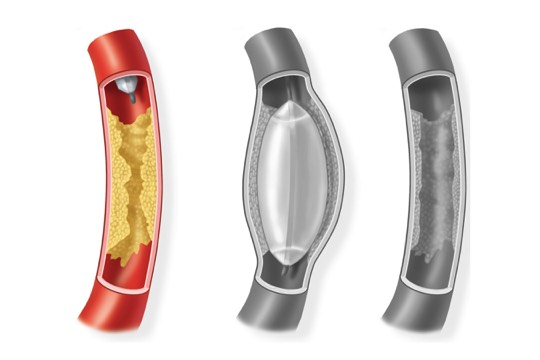 A balloon tipped catheter is inserted into the artery and threaded to the narrowing and blockage.Surgery Step 2
A balloon tipped catheter is inserted into the artery and threaded to the narrowing and blockage.Surgery Step 2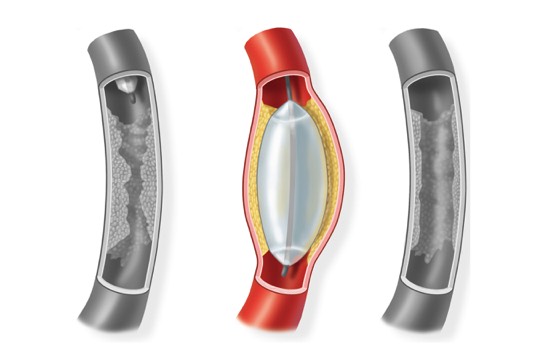 The balloon is inflated and deflated several times. This presses the plaque against the artery walls.Surgery Step 3
The balloon is inflated and deflated several times. This presses the plaque against the artery walls.Surgery Step 3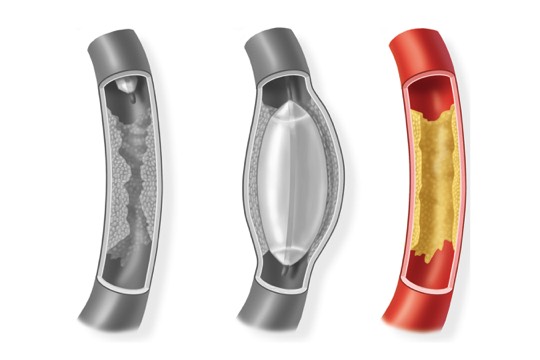 Once the artery is open, the balloon is deflated and removed. Blood flows freely through the widened channel.
Once the artery is open, the balloon is deflated and removed. Blood flows freely through the widened channel.
Stenting is the insertion of a tiny wire mesh device into an artery to hold it open. A carotid artery stent is a flexible wire mesh tube. Once it is placed, it remains in the artery. The stent is resistant to pressure and crushing, so it adjusts easily when you move your head and neck. The stent fits snugly in the artery so it won’t slip out of place.Surgery Step 1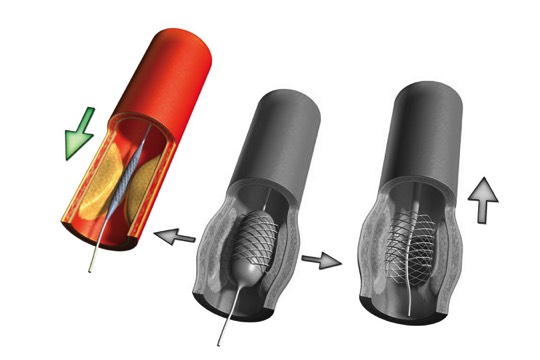 A collapsed stent is mounted onto a balloon catheter and guided across the blockage.Surgery Step 2
A collapsed stent is mounted onto a balloon catheter and guided across the blockage.Surgery Step 2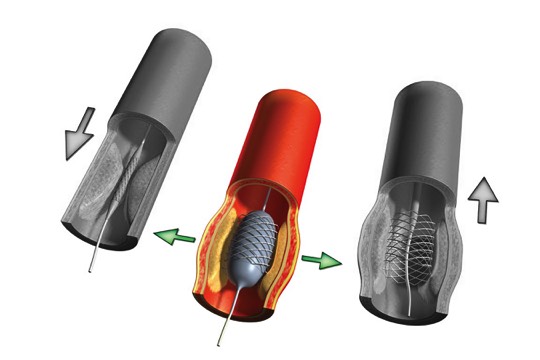 The balloon is inflated to open the stent, which locks into place inside the artery.Surgery Step 3
The balloon is inflated to open the stent, which locks into place inside the artery.Surgery Step 3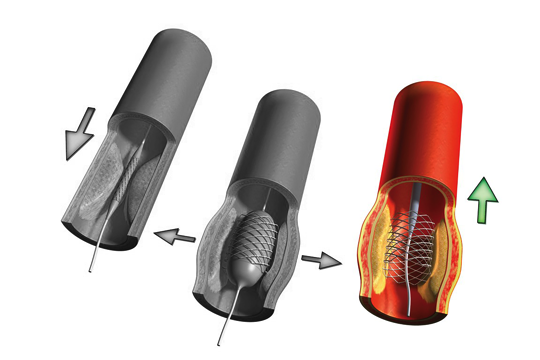 The balloon is deflated and removed. The stent remains in place, holding the artery open.
The balloon is deflated and removed. The stent remains in place, holding the artery open.
What is Carotid Endarterectomy?The surgical procedure to remove plaque is called a carotid endarterectomy. It is performed under full anesthesia. It is typically indicated for patients who have had symptoms (stroke or TIA) and have blockage greater than 50%. It is also recommended for patients who have no symptoms and have blockage greater than 60%.
The procedure is safe and long lasting when performed by an experienced vascular surgeon. Although safe, the procedure carries a small risk of stroke, which is less than 1% in our experience.A skin incision is made in the neck and the carotid artery is located. During this time, the carotid artery on the other side of the neck carries blood flow to the brain. The surgeon makes an incision in the artery over the blocked area. The plaque buildup is physically peeled out and removed. The artery is then closed with sutures, and the skin incision is sutured closed.
Subsequent to the operation, patients are monitored overnight in the ICU, and discharged the next day. There is very little discomfort with this procedure.Surgery Step 1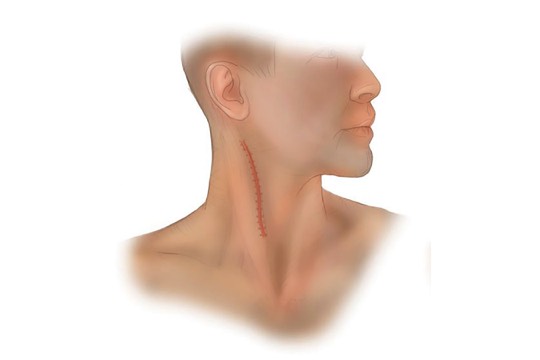 The surgeon makes an incision in the skin over the carotid artery. The image below shows a common incision site and length.Surgery Step 2
The surgeon makes an incision in the skin over the carotid artery. The image below shows a common incision site and length.Surgery Step 2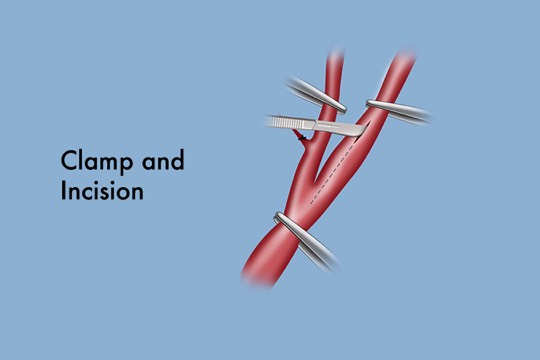 The surgeon places clamps on the artery above and below the blockage. The surgeon makes an incision into the artery.Surgery Step 3
The surgeon places clamps on the artery above and below the blockage. The surgeon makes an incision into the artery.Surgery Step 3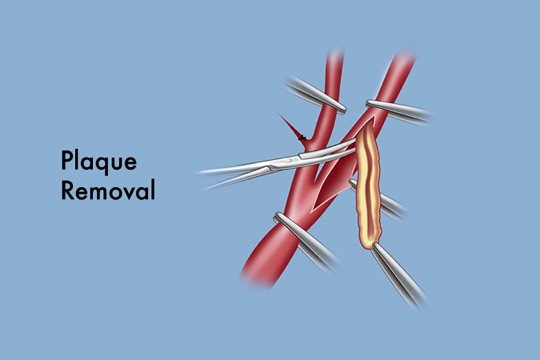 The surgeon loosens the plaque from the artery wall. The plaque is removed, often in a single piece.Surgery Step 4
The surgeon loosens the plaque from the artery wall. The plaque is removed, often in a single piece.Surgery Step 4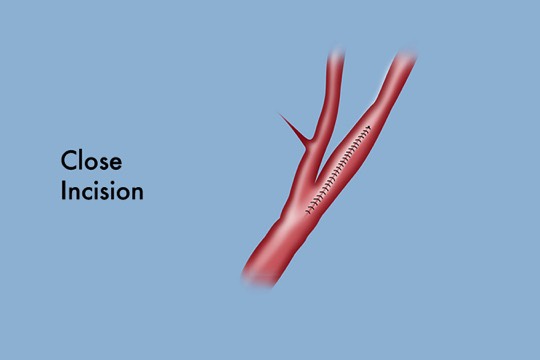 The surgeon sutures the artery incision closed, and then the skin incision is sutured closed.
The surgeon sutures the artery incision closed, and then the skin incision is sutured closed.
What is Transcarotid Arterial Revascularization / TCAR?For patients with carotid artery disease who are at risk for traditional open surgery, a less-invasive, clinically proven alternative called TCAR, is available. The TCAR procedure is performed through a small incision at your neckline just above your clavicle. This incision is much smaller than a typical CEA incision. The surgeon will place a tube directly into your carotid artery and connect it to a system that will temporarily direct blood flow away from your brain to protect against dangerous debris from reaching your brain during the procedure. Your blood will flow through the system and any material will be captured in a filter outside the body. Your filtered blood will then be returned through a second tube in your upper thigh. A carotid stent will be implanted to stabilize the plaque and prevent future strokes. After the stent is placed successfully, flow reversal is turned off and blood flow resumes in its normal direction.
TCAR
-
After Treatment
Your recovery at home should take about a week. After you’ve recovered, be sure to follow your doctor’s instructions for follow up.
Recovering at Home
Take it easy, but get back to your normal routine as much as possible.- Take medications as prescribed.
- Keep the neck incision or the groin puncture site clean and dry.
- Avoid lifting anything over 10lbs. until your doctor informs you it’s okay to do so.
- Don’t drive until your doctor clears you to do so.
- Follow your doctor’s orders regarding shaving.
- If you had stenting, shower instead of taking tub baths for a few days.
Your Follow Up
Within a month after your procedure, you’ll have a follow-up exam, and may have some tests. These tests may include an ultrasound. You will be monitored on a regular basis, according to your doctor’s instructions. In rare cases, the carotid can narrow again. If this happens, it can often be treated again with balloon angioplasty.
Taking Control of Your Health
There’s a lot you can do to improve your health. To help make your procedure a success, do the following:- Take medication as prescribed.
- If you smoke, QUIT! This can reduce your future risk of stroke or heart attack.
- Manage conditions such as, high blood pressure, diabetes, and cholesterol problems.
- Exercise and eat healthy.
